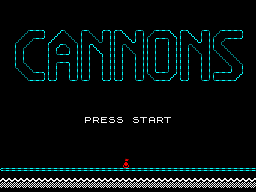Cannons
Strategy, © KesieV 2018

One of the first games I've made once the Wright! Magazine project derailed from his platformer-only purpose was Almost Soccer, a simple soccer game I've made 3 years ago. In his tiny article I said that it was "the only game that caught [my colleagues] interest and that is... bittersweet funny".
Probably I was right on mentioning the stereotypical connection with the national sport as the main reason, but the bond soccer/videogames might be even deeper in Italy: soccer players has been heroes for entire generations and they have been testimonials for not soccer-related videogame advertisements during the 80s, like in the Walter Zenga's Sega Master System II spot. Since videogames were basically toys in Italy, many kids have learned about and started loving videogames from soccer players in TV - so soccer may have been a crucial videogame catalyst here.
I knew that there was an even more attractive feature I could add to games in order to hook them: the infamous competitive local multiplayer. The first game I've made that offered that kind of gameplay was a Pong clone, mostly because most Wright! game controls were limited to directional buttons and two action keys and a Pong clone just needed 4 of them - no game engine changes needed for multiplayer. And it was a sport game after all. Sadly it has been ignored due to its basic gameplay and the reputation of ancient form of entertainment.
But the unexpected attention this Artillery (1976) inspired game gained in my office testified that there were a lot more to learn and that I've missed a crucial point of the previous lesson.
First: multiplayer doesn't have to happen in real-time, and the huge success of the Worms (1995) series, known even by not videogame player colleagues, testified. While the simultaneous interacton is more immersive and zeroes downtime for players, if turns are short and intense enough, it's ok.
Second: anything that's not known is brand new - even the old. It's an old trick played by politicians, fake news publishers, videogame designers and speakers in general.
Soccer is a renown game and, since it's still played today, my version could rely on its nostalgia effect given by the retro-style I gave. Pong, instead, isn't played as-is anymore: it gave its basis to videogames and then it disappeared, dissolved in more interesting games. Despite my remake was quite faithful to the original, everybody knows Pong as the game that has had its day and it's not interesting anymore. But predecessor titles of a consolidated videogame genres lives in a golden limbo: since they still contains elements of a more recent and relatively successful game but they are buried in the past, they might be perceived as simplified but still fun versions of a new game. And so this Cannons has been described and lived by my colleagues: a simplified version of Worms that fits lunch breaks.
Putting it simply, every precursor is a nice demake and I think that there is a whole niche of gamers that are living retrogaming like that.
A key example is the recent evolution of the Doom (1993) series. The first person shooter genre evolved in slower and more strategic gameplay, intense narrative with in-game cutscenes and quick time events arranged in order to enhance the immersivity of cinematic events.
The Doom brand had to evolve in order to be accepted by the current generation of gamers and it tried following the same path traced by other FPSs: in my humble opinion, as a single player gamer, the slow and narrative 2004 Doom 3 failed on being the king of shooters once again.
It doesn't mean that the developers made a mistake: it just followed the right path in the wrong way. For me, Doom 3 was just an average modern shooter. While the next step looks granted - fixing what's broken - the unknown old concept opened a new alternative: the rebooted Doom (2016) features a cleverly evolved version of the raw action mechanics of the original Doom, heading down a path far from modern shooters. And I deeply loved it.
It was a relative breath of fresh air for younger gamers and the absolute return to the die-hard action for older gamers. Everybody wins. Good luck for the sequel Doom Eternal... will the trick work twice?
Plot!
Soldier! You're the gunner of our latest outpost. If you destroy the last enemy outpost, the victory will be ours! Every shoot counts: feel the wind, take aim, charge your shoot and win!
Use LEFT/RIGHT for changing the cannon aim. Hold down the A BUTTON to charge your shot and release it to fire. You can enable two modifiers using the cheats menu: the Warp Mode, suggested by my colleagues, that allow the bullets to warp from a side of the screen to the other one, and the Kebab Mode, played during the Wright! project closing event, that makes the game playable using the A BUTTON only.
(Want to share something? You can find me on Twitter!)
 Install / Add to home
Install / Add to home
 View game sources
...or play it online below!
View game sources
...or play it online below!